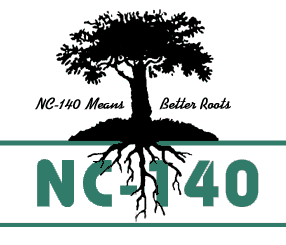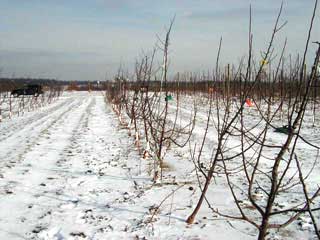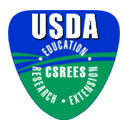 NC-140 Regional Rootstock Research Project
NC-140 Regional Rootstock Research Project
PUBLICATION
New Apple Rootstocks promising for commercial growers
From: The Fruit Growers News, 41(5): 6-8.
By
Ron Perry, Department of Horticulture, Michigan State University, East Lansing, MI
Peter Hirst, Department of Horticulture and Landscape, Purdue University, Lafayette, IN
Win Cowgill, Professor and Area Fruit Agent, Rutgers Cooperative Extension, NJ
Jon Clements, Tree Fruit Extension Specialist, UMass Horticultural Research Center, Belchertown, MA
There are a number of new rootstocks that are being made available to commercial growers. Many of these rootstocks have been established in trials across North America to determine their commercial value. One group of scientists organized themselves, known as NC-140, over 25 years ago to collectively evaluate new and interesting fruit tree rootstocks. NC-140 receives most of it's funding from federal sources, although both IDFTA and local state growers associations have provided essential additional support over many years. With this support, NC-140 has established itself as the model regional project (internationally renowned) that uniformly evaluates elite rootstocks and presents it's unbiased findings to its users. The benefits of this committee of scientists from over 30 institutions have been tremendous as a vehicle for exchange of information regarding performance of elite pome and stone fruit rootstocks. Researchers meet and agree on scion varieties and protocols under which the rootstocks are assessed so that assessment techniques are as uniform as possible across sites. It is a process that can take 3-4 years to plan and establish each trial, followed by 10 years of data collection and reporting. The process can be slow but systematically valuable in making an independent assessment. While these rootstocks are being evaluated, nothing stops the growers who are grappling with staying alive in their businesses, from independently trying these new stocks on their own.
This article was written to address a presentation made by Dr. Terence Robinson at the recently held IDFTA annual meeting in Kelowna, BC, Canada. The four of us have been members of both IDFTA and the NC-140 committee for a number of years and were in attendance during Dr. Robinson's presentation. Growers have been calling us and other members of the NC-140 group to determine the merits of the new CG (Cornell-Geneva) rootstocks from New York. Some of these rootstocks have been tested in a number of sites for many years in the NC-140 program while others have not been widely tested outside of New York. These rootstocks do have excellent potential. The apple rootstock breeding program was established in New York with the specific goal of developing new stocks that could tolerate North American problems such as Fireblight, Phytophthora and Wooly Aphids and still be productive and control vigor. It is our job, thus to at least inform our local industries and point out attributes, negatives and the unknowns of these rootstocks to better enable local growers to make informed planting decisions.
G.30
G.30 is probably the most widely tested of the stocks we will discuss in this article.
|
G.30 has been impressive in Michigan (Clarksville) plots since evaluation began in 1992. Trees in 2 separate trials with Liberty (1992) and Gala (1994) scions showed excellent precocity (earliness to bare) and cropping throughout testing at that site. Two trees have been lost in each planting since established due to union breakage. Additionally in Michigan, a hundred trees each of Jonagored, Marshal Mac and Fuji (all supported with stake and a single wire) and Ace Red Delicious was established in an independent planting in 1997. The Red Delicious trees are not supported and some 10-15% of the trees started leaning severely and had a stake driven to provide supplemental support this past year (Fig. 1). Additionally, G.30 is being tested in a 1999 trial with Mac scion at Clarksville (CHES) and the Northwest Hort. Station (NHRS). In all, only a few trees have been lost due to union breakage in these plantings over the years. Experience in Michigan and that of others (Gala trials) suggest that growers should plan on providing support to the trees. Due to the brittle nature of Gala, two wires are recommended. Tree vigor is supposed to be between M.26 and M.7. In the Michigan Gala trial, trees are smaller and more productive than M.26. Dr. Terence Robinson, researcher with the Department of Horticulture, Geneva AES, NY, who is coordinating distribution and trialing of Geneva rootstocks, explains that likely, it is due to the precocious nature of the scion combined with early cropping influence imparted by G.30. While trees on this rootstock maybe a little vigorous for high density enthusiasts in fertile orchard sites and longer growing seasons, this stock has excellent potential for the droughty, sandy soils of Northern Michigan and New England. Be aware that G.30 is resistant to fireblight, but as with other stocks in this series, no evidence exists that resistance is transferred to the scion. |
 Fig. 1. Ace Red Delicious / G. 30 after 5 years. Center tree needed metal stake support and trees in foreground are leaning |
Overall G.30 is far superior to M.26 and M.7 in productivity and in our trials, fruit size does not appear to suffer. The question mark for this stock is brittle unions. With Gala as the scion, 7 of the 8 trees of the 1994 NC-140 trial growing in Indiana broke off at the graft union before the trees were 5 years old. Although trees were supported by a single conduit, this was obviously insufficient for this cultivar/rootstock combination. A few trees of Gala/M.26 were also lost due to graft failure at this site. We don't have long enough experience with G.30 across a wide range of sites to know if this graft breakage problem is just with Gala or across a range of rootstocks. In New Jersey, G.30 in the same NC-140 trial at the Rutgers Snyder Farm in Northwestern NJ demonstrated the same serious breakage problem, with 7 of 10 trees breaking off. There were no differences in fruit size. In a second NJ 1998 trial, G.30 was compared to M.26. Cumulative yield on all four cultivars on G.30 was statistically higher than on M.26. Again there was no difference in fruit size between the rootstocks.
G.16
G.16 has been under test in Michigan (CHES), UMass(CSO) and NJ since 1998 with Gala, Jonagold (1998), Mac and Gala (1999) scions. In a 1998 test in Michigan, Gala on G.16 crops as well as M.9 but is more vigorous (more like M.26). The Jonagold trees at that site are the same size as M.9 EMLA and just as productive. The Macs and Galas in Mass. are both the same size as M.9. At the NJ site the 1998 trial, tree size, cumulative yield and cumulative yield efficiency is comparable to M.9. Dr. Robinson indicates that in the NC-140 tests, G.16 is equivalent to M.9 in vigor and in productivity, but has the added attribute of resistance to fireblight. He also indicates that this rootstock does not produce Burr Knots, which is a problem for our M.9 and M.26 plantings in hosting dogwood borer infestations. He also indicates that it has one flaw in its apparent sensitivity to a couple of latent viruses such as stem Stem Pitting Virus. Many growers might overlook this detraction to be able to plant a fireblight resistant rootstock that is as small and productive as M.9 EMLA. Realize that the oldest trials outside of NY were established in 1998 and thus results and experience is very preliminary.
G.41
Jonagold trees in the 1998 CHES trial are slightly weaker than M.9 EMLA and G.16 but equivalent in productivity. At the UMass CSO site, Mac tress on G. 41 did not differ in size or yield from M.9 after three years in the orchard. Dr. Robinson suggests in other trials that this stock is similar to M.9 in vigor and resistant to fireblight. G.41 has not been included in evaluations in NJ and IN.
G.202
Liberty was planted at a close spacing in a Vertical Axe trial in 1992 at CHES on G.202 and other rootstocks. After 8 years, it was the most productive stock, similar to M.26 in vigor. Trees were compared to both M.9 and M.26 in that planting. G.202 has been found to be impressive in New Zealand, which has spawned a more immediate propagation schedule in that country. A newer NC-140 trial with Mac and Gala scions was established in Michigan (CHES and NHRS) and at the UMass CSO site in spring 1999. This rootstock has not been included in evaluations in NJ and IN.
G.935
The only experience we have with this stock is in a Michigan trial established in 1999 at CHES with Mac scion. No data as yet of any significance. This rootstock has not been included in evaluations in Mass, NJ and IN.
In Summary
Dr. Robinson announced at this meeting that G.30 and G.16 are available from nurseries this spring (2002) and that G.41, G.11, G.202 (all similar to M.26 size) and G.935 (similar to M.26 -M.7 size) will all be available in 2004. Except for G.30, we have had little to no experience with these stocks and can not recommend their planting, except on an experimental basis. G.30 appears to have some commercial potential, but growers who establish trees on this rootstock must be aware of the concern for tree loss with some varieties, especially if not supported adequately. These rootstocks offer the promise of improved productivity over M.26 and M.7 and lesser risk from fireblight than M.9 and M.26.
All of these stocks look promising at this time but we, along with many NC-140 members, are hesitant about recommending them for large scale commercial plantings until they have been more widely tested. We do, however, encourage growers to put out small test plantings on their farms as these rootstocks become available to gain some experience with them. We researchers will continue to evaluate these stocks and update the industry on any new findings from the multitude of cooperative trials across North America. At this point we need to continue to support Dr. Robinson's efforts and that of his colleagues at Geneva and especially Dr. Gennaro Fazio, the new USDA apple rootstock breeder at Geneva.
For more information on rootstocks visit the USDA-ARS Cornell University Apple Rootstock Breeding and Evaluation Program website at http://www.nysaes.cornell.edu/hort/breeders/appleroots/applerootstocks.html
And the NC-140 website at http://www.NC140.org
 NC-140
Regional Rootstock Research Project
NC-140
Regional Rootstock Research Project
Created by Win and Jon
webmaster@virtualorchard.net
Site Last Modified: